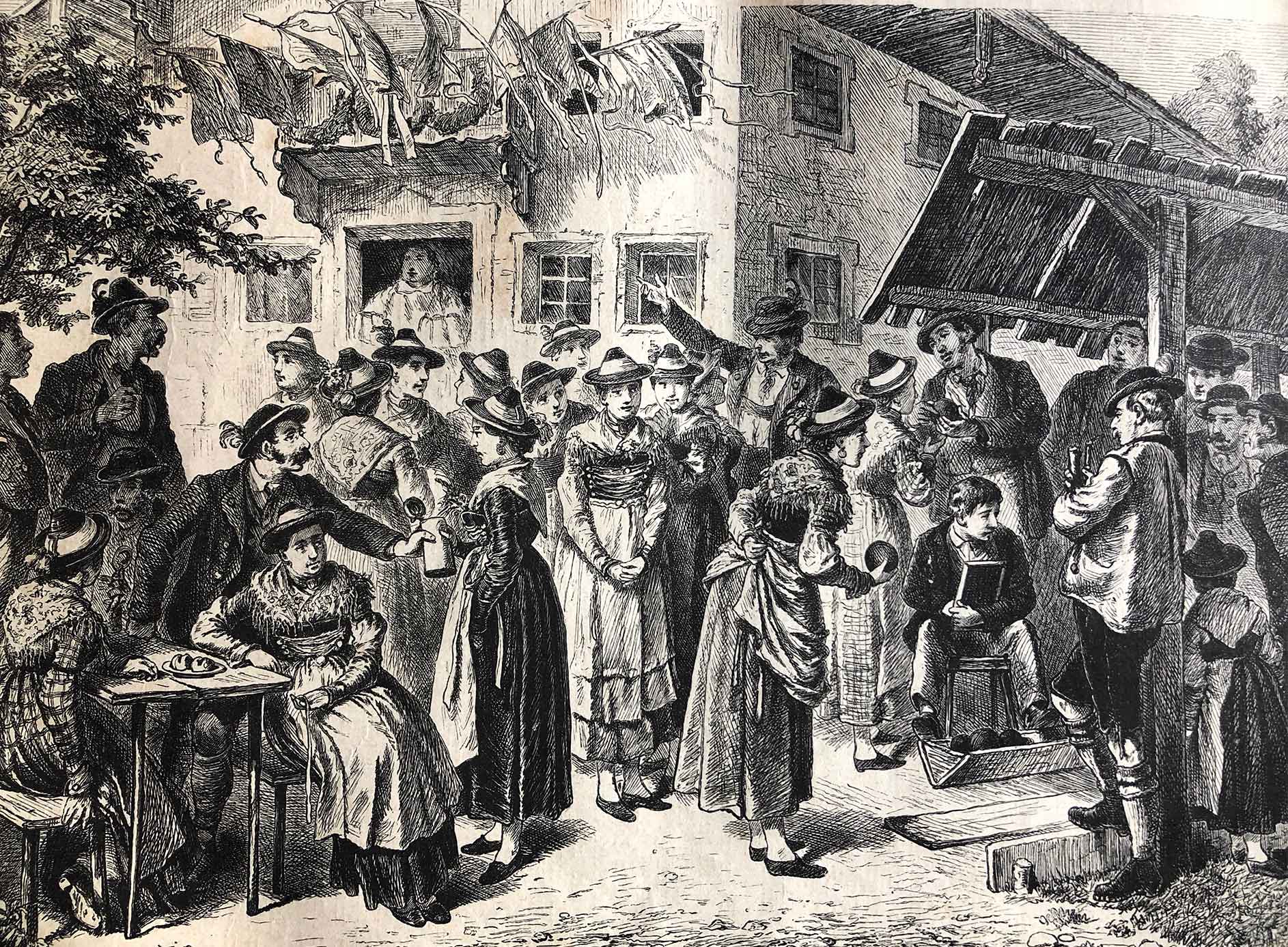The game sounds straightforward enough. “One team rolls the little white ball down the rink,” says Dave Allen (District 11 Waterloo Region). “They try to get a bowl close to it, and you try to get a bowl close. When you run out of bowls, you walk down and count up the points.”
As a lawn bowler myself, I know there’s more to it, but this is how Allen shorthands the game for people who watch over the fence on summer evenings at the Preston Lawn Bowling Club in Cambridge, Ont. Some 20 years ago, he was one of the fence spectators, looking for a counterpart to curling in winter. The bowls club was reopening, newly energized, after being closed for a few years. Allen thought the game would be fun and saw an opportunity to help build a community organization.
Around the same time, Flo Barclay (District 27 Ottawa-Carleton) was also looking for a summer retirement activity. “Golf didn’t really appeal to me,” she says. “I like having people around.” In lawn bowling, she found a sport where she could learn the basics and start playing alongside experienced bowlers almost immediately.
“You don’t have to be really good to play at the club level,” says Barclay. But she quickly began venturing beyond her home club to enter Ottawa-area tournaments. Within three years, she was competing at the provincial novice championships. More recently, she began playing through the winter in Sarasota, Fla., against American and British bowlers, and competed in three U.S. Opens, winning a silver and two bronze medals in pairs and fours competitions. “I still maintain friendships with people in all the places where I’ve bowled,” she says.
One of Barclay’s favourite tournaments is an interprovincial event that alternates between Quebec and Ontario host clubs. While there are clubs, and about 14,000 bowlers, across Canada, Ontario has the largest number of both. Bowls Canada, the sport’s national body, has a find-a-club feature on its website, bowlscanada.com.
Membership did drop due to pandemic restrictions in 2020, but many bowlers expect the clubs will bounce back quickly, especially since physical distancing is easy on a bowling green.
The bigger challenge: the perception that lawn bowling is a “sport” for fusty old people. In fact, the top players in the world today are in their 20s and 30s. But older players remain competitive because strategy and accuracy are so important. “Three generations can play together, and an 18-year-old can beat an 81-year-old,” says Allen. “Or vice versa.” It’s also a sport in which roughly equal numbers of women and men participate.
Allen’s 30-second over-the-fence explanation of lawn bowling omits a couple of important details. For one, the bowls — which are never called balls — are not true spheres. They have a slightly eccentric shape, a bit like an egg, that causes them to always travel along a curved path.
Bowls often roll up to (or “kiss”) the little white ball, called the jack, and move it, changing the game dramatically. Experienced bowlers anticipate this and — to adapt Walter Gretzky’s famous quote about hockey pucks — bowl to where the jack is going, not where it has been. “It’s a thinking game,” says Barclay, “as much as it is a physical game.”
This mental challenge appeals to Fabian Walsh (District 34 York Region), who has bowled for five seasons at Toronto’s Cosburn Park. “I really have to think and focus and pay attention — and learn,” he says. He describes how, with each bowl, he adjusts his aim and the weight he applies to the delivery, while focusing on the target. There’s a lot going on, and even if the bowls don’t always go where they’re supposed to, the game “keeps me sharp,” he says.
There are physical benefits too. Delivering the bowl, which weighs about 1.5 kilograms, combines a gentle lunge forward with a controlled pendulum-like arm swing. “Your lateral balance is constantly under stress,” says Don Panagapka (District 11 Waterloo Region). “Your muscles have to react accordingly.” The retired phys-ed teacher points out that walking back and forth on the green also adds up — to at least a few kilometres in a tournament.
Panagapka bowls at Saugeen Shores Lawn Bowling Club in Southampton, Ont., with his wife, Charlotte, who is also a retired teacher. At the club, he used his teaching experience to help develop a streamlined introductory program for new bowlers. “We try for maximum participation right from the start,” he says. “You should enjoy what happens in the game, without getting bogged down with instruction.”
At most clubs, games are organized as “jitneys,” bowling slang for a casual pickup game. Arrive at the club and you’re put on a team, explains Shirley Greenwood (District 10 Bruce, Grey, Dufferin), who has acted as the club drawmaster for many games in Hanover, Ont. Teachers, she says, often take on this role because “we’re good at organizing people into teams.” For new bowlers especially, she says, “I quite like trebles.” This three-people-per-team format lets novices play with, and learn from, more senior bowlers.
Pat Elfer (District 23 North York) is in her last year as a novice. I met Pat in 2016, when she and her partner, Kelly, started bowling. A friend in their church had mentioned Toronto Rainbowlers, an LGBTQ lawn bowling group that plays at Cosburn Park. “We were hooked the day we walked in,” she says. “The chatter, the energy and the fun — it was great.”
Elfer says that, after spending decades in the closet while teaching in the Catholic school system, she hadn’t developed many connections in the LGBTQ community. At the same time, she doesn’t see a lot of other environments where gay men interact regularly with lesbians. Rainbowlers “is very freeing,” she says. “It’s relaxing. We come in and make fun of the guys, and they make fun of us.”
“We’ve truly extended our group of friends through lawn bowling,” adds Elfer. “We’re part of a community.”

The backstory
The British soldiers stationed at Port Royal, in Nova Scotia, had already been bowling for a few years before they received official permission in 1734 to build Canada’s first green. Technically, the sport was still illegal. Edward III had restricted lawn bowling in 1366 — it distracted his archers — and Henry VIII later banned it on all days but Christmas. The sport expanded in the 19th century, not so much because the ban was repealed in 1845, but because the mechanical lawn mower was invented in 1830.
Talking bowls
Jack: The small, white target ball; also called the kitty or the cat.
Jack high: What a bowl is called when it travels the same distance as the jack.
Rink: A strip of grass used for one game.
Green: The play area containing several rinks, usually eight, side by side.
Cabbage: A badly delivered bowl that wobbles and bounces down the rink.
Wick: To deliver a bowl that hits another before rolling to the jack.
Promote: To hit a resting bowl, moving it up toward the jack.
Dump: To toss, rather than roll, the bowl when delivering it.



Talking bowls
Jack: The small, white target ball; also called the kitty or the cat.
Jack high: What a bowl is called when it travels the same distance as the jack.
Rink: A strip of grass used for one game.
Green: The play area containing several rinks, usually eight, side by side.
Cabbage: A badly delivered bowl that wobbles and bounces down the rink.
Wick: To deliver a bowl that hits another before rolling to the jack.
Promote: To hit a resting bowl, moving it up toward the jack.
Dump: To toss, rather than roll, the bowl when delivering it.










